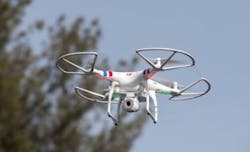UAV roundup 2/27: The latest in unmanned aerial vehicle news
February saw no shortage of news when it came to UAVs in the United States. In fact, it was quite the eventful month, headlined by the Federal Aviation Administration (FAA) finally proposing a framework of regulations that would allow routine use of certain small UAVs in today’s aviation system, while maintaining flexibility to accommodate future technological innovations.
MORE ARTICLES
UAVs create 3D model of Christ the Redeemer statue in Rio de Janeiro
FAA issues proposed rule on regulations for commercials UAVs
Vision-guided humanoid robot and UAV work in tandem to fight fires
The proposal outlines safety rules for UAVs less than 55 pounds conducting non-recreational operations and would limit flights to daylight and visual-line-of-sight operations. It also addresses height restrictions, operator certification, optional use of a visual observer, aircraft registration and marking, and operational limits. (See additional highlights here.)
AUVSI responds to proposed rule
Following the release, the president of the Association for Unmanned Vehicle Systems International (AUVSI) Brian Wynne issued some statements, noting that the proposed rule is a "good first step" to allow commercial use of these systems.
"This proposed rule is a critical milestone in the UAS integration process, and one that is long overdue. UAS technology has largely remained grounded while many prospective users wait for the regulatory framework to catch up," said Wynne, in a statement released by AUVSI.
He added, “"This is a good first step in an evolutionary process that brings us closer to realizing the many societal and economic benefits of UAS technology. We're currently reviewing the details of the proposed rule, and we look forward to addressing its specific provisions once we've had time to fully digest the rule. As an industry we believe it's important that the final rule enables the many civil and commercial uses for UAS technology in a safe and responsible manner and without being unnecessarily restrictive."
In a study done by the AUVSI, it was noted that the UAV industry could create more than 100,000 jobs and $82 billion in economic impact in the first decade following the integration of UAVs.
If the safety and precautionary measures can be ironed out to the point where all parties agree, the integration of UAVs into public space should provide a nice opportunity to the machine vision market, who can provide imaging payload solutions, as well as 3D mapping and image processing services, such as those outlined here.
Additional FAA exemptions granted
The latest round of authorizations granted via Section 333 exemptions to operate UAVs in the U.S. national airspace saw a number of companies and organizations receive permission to fly. These include:
Page 1 | Page 2
About the Author

James Carroll
Former VSD Editor James Carroll joined the team 2013. Carroll covered machine vision and imaging from numerous angles, including application stories, industry news, market updates, and new products. In addition to writing and editing articles, Carroll managed the Innovators Awards program and webcasts.

